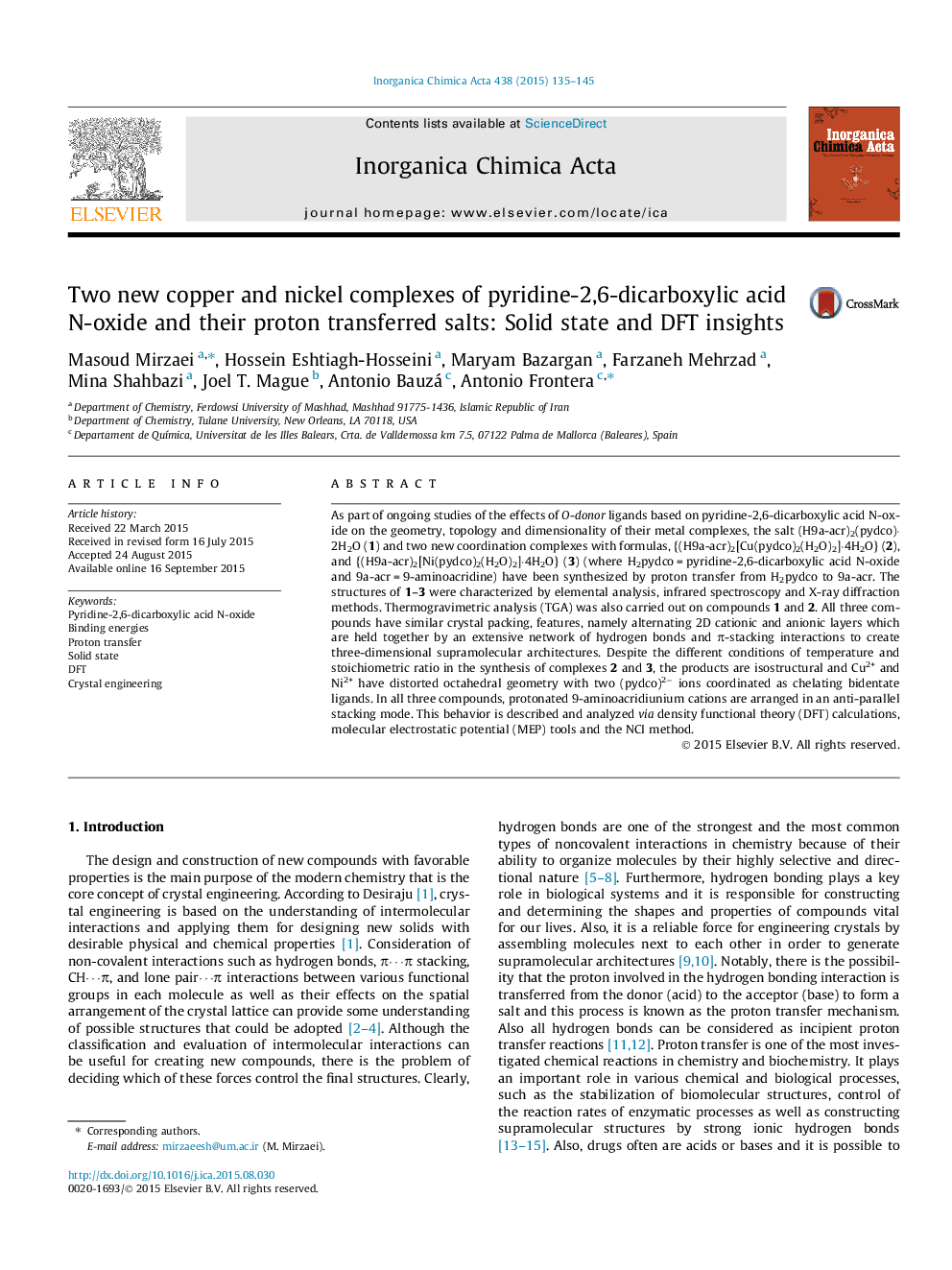| کد مقاله | کد نشریه | سال انتشار | مقاله انگلیسی | نسخه تمام متن |
|---|---|---|---|---|
| 1308683 | 1499151 | 2015 | 11 صفحه PDF | دانلود رایگان |

• Two new complexes and one proton transferred salts of pydco have been synthesized for the first time.
• The effects of O-donor ligands based on pydco on the geometry, topology, and dimensionality was investigated.
• All crystal packing of compounds exhibiting alternating 2D cationic and anionic layers.
• These layers are held together through hydrogen bonds and π-stacking interactions to create 2D supramolecular architectures.
• The anti-parallel stacking mode is analyzed via DFT calculations, MEP tools, and the NCI method.
As part of ongoing studies of the effects of O-donor ligands based on pyridine-2,6-dicarboxylic acid N-oxide on the geometry, topology and dimensionality of their metal complexes, the salt (H9a-acr)2(pydco)·2H2O (1) and two new coordination complexes with formulas, {(H9a-acr)2[Cu(pydco)2(H2O)2]·4H2O} (2), and {(H9a-acr)2[Ni(pydco)2(H2O)2]·4H2O} (3) (where H2pydco = pyridine-2,6-dicarboxylic acid N-oxide and 9a-acr = 9-aminoacridine) have been synthesized by proton transfer from H2pydco to 9a-acr. The structures of 1–3 were characterized by elemental analysis, infrared spectroscopy and X-ray diffraction methods. Thermogravimetric analysis (TGA) was also carried out on compounds 1 and 2. All three compounds have similar crystal packing, features, namely alternating 2D cationic and anionic layers which are held together by an extensive network of hydrogen bonds and π-stacking interactions to create three-dimensional supramolecular architectures. Despite the different conditions of temperature and stoichiometric ratio in the synthesis of complexes 2 and 3, the products are isostructural and Cu2+ and Ni2+ have distorted octahedral geometry with two (pydco)2− ions coordinated as chelating bidentate ligands. In all three compounds, protonated 9-aminoacridiunium cations are arranged in an anti-parallel stacking mode. This behavior is described and analyzed via density functional theory (DFT) calculations, molecular electrostatic potential (MEP) tools and the NCI method.
Within three synthesized salts (H9a-acr)2(pydco)·2H2O (1), {(H9a-acr)2[Cu(pydco)2(H2O)2]·4H2O} (2), and {(H9a-acr)2[Ni(pydco)2(H2O)2]·4H2O} (3), alternating cationic and anionic layer assemblies in the solid state were formed. This study demonstrates the effect of complexed metals on the crystal packing and the importance of the noncovalent interactions like hydrogen bonding and π–π stacking on the formation and stabilization of 3D supramolecular architectures via density functional theory (DFT) calculations, molecular electrostatic potential (MEP) tools and the NCI method.Figure optionsDownload as PowerPoint slide
Journal: Inorganica Chimica Acta - Volume 438, 1 November 2015, Pages 135–145